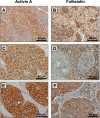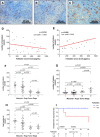Follistatin impacts Tumor Angiogenesis and Outcome in Thymic Epithelial Tumors
- PMID: 31757999
- PMCID: PMC6874542
- DOI: 10.1038/s41598-019-53671-8
Follistatin impacts Tumor Angiogenesis and Outcome in Thymic Epithelial Tumors
Abstract
Tumor angiogenesis is a key factor in the progression of thymic epithelial tumors (TETs). Activin A, a member of the TGFβ family, and its antagonist Follistatin are involved in several human malignancies and angiogenesis. We investigated Activin A and Follistatin in serum and tumor tissue of patients with TETs in relation to microvessel density (MVD), WHO histology classification, tumor stage and outcome. Membranous Activin A expression was detected in all tumor tissues of TETs, while Follistatin staining was found in tumor nuclei and cytoplasm. Patients with TETs presented with significantly higher Activin A and Follistatin serum concentrations compared to healthy volunteers, respectively. Follistatin serum concentrations correlated significantly with tumor stage and decreased to physiologic values after complete tumor resection. Follistatin serum concentrations correlated further with MVD and were associated with significantly worse freedom from recurrence (FFR). Low numbers of immature tumor vessels represented even an independent worse prognostic factor for FFR at multivariable analysis. To conclude, the Activin A - Follistatin axis is involved in the pathogenesis of TETs. Further study of Follistatin and Activin A in TETs is warranted as the molecules may serve as targets to inhibit tumor angiogenesis and tumor progression.
Conflict of interest statement
The authors declare no competing interests.
Figures



References
MeSH terms
Substances
Supplementary concepts
LinkOut - more resources
Full Text Sources
Medical

